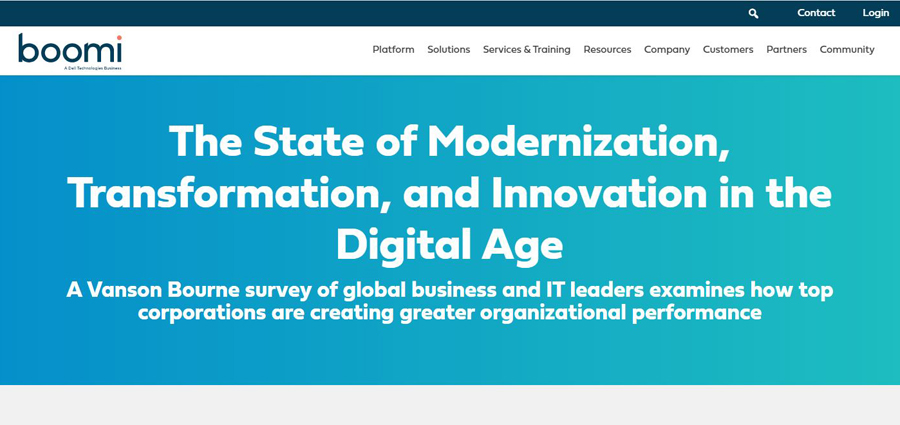Boomi™, a Dell Technologies™ business, today announced a new global survey, commissioned with Vanson Bourne that reveals although organizations are reaping the rewards of IT modernization, digital transformation and innovation, there’s still more work to do. Now more than ever, technology supports and drives every business, from banks to retailers, whether customer-facing or internally focused. Companies that find ways to maximize their budget when investing in digital strategies and technologies have the opportunity to improve their ROI by more than 1,000%.
The report, “The State of Modernization, Transformation, and Innovation in the Digital Age,” outlines that 59 percent of survey respondents said effectively using technology has been the key to transformational success. However, 1 in 2 decision makers admit their company isn’t innovating at a competitive rate. Organizations still face multiple challenges to roll out their modernization, innovation, and transformation programs more quickly and efficiently.
The survey of more than 1,200 IT and business decision makers around the world, including Asia Pacific (APAC), shows the top barriers for digital transformation and innovation efforts include insufficient in-house skills (41 percent) followed by a restrictive budget (33 percent). APAC respondents find that technical knowledge (56 percent) is one of their organization’s biggest challenges, more so than their counterparts in North America and Europe (46 percent and 43 percent respectively). The data suggests that although APAC organizations might have intentions to modernize, they are currently more likely to struggle finding the right expertise required to do so successfully.
“Businesses in APAC have realized the importance of converging and simplifying automation technologies to fully realize positive business outcomes. Many organizations are faced with multiple, poorly integrated IT environments, tight budgets and limited in-house skills,” said Ajit Melarkode, Vice President Asia Pacific and Japan (APJ) at Boomi. “While businesses often find themselves ‘out changed’ by competitors and peers, the research also shows positive signs, with organizations exploring new technologies and processes in anticipation of drastic advancements in the next decade.”
From the report, artificial intelligence (46 per cent) is the standout technology for organizations in the next five years, followed by security innovation (35 percent) and big data analytics (35 percent). According to respondents, big data analytics is receiving the biggest investment as part of their innovation initiatives.
“The next decade will undergo an even more rapid pace of change than the 2000s and 2010s,” said Chris Port, Chief Operating Officer for Boomi. “Though modernization, transformation, and innovation have paid dividends in recent years, organizations can’t afford to rest on their laurels. Especially now. Not when business priorities, drivers of change, and technology needs are rapidly converging, as reflected in this survey.”
The Vanson Bourne survey went on to uncover:
• Businesses are turning to ‘low-code’ to drive transformation initiatives: Companies are trying to do more with employees who have less technical expertise. That’s why investing in low code platforms is a big focus for more than half of enterprises that don’t have one already. Almost 50 percent anticipate they will introduce a low-code development platform before the end of 2020.
• Companies are honing in on customer experience and employee productivity: Today’s transformation efforts are focused primarily on customer experience (54 percent) and employee productivity (50 percent). Both of these areas are crucial for supporting more modern, agile customers and workforces. Business and IT decision makers agree the biggest benefit they have seen from modernization is improved customer experience (49 percent).
• The CEO currently drives innovation among C-suite, but within three years innovation will be companywide responsibility: Organizations still need to modernize, transform and innovate, and it will take a companywide shift to make that happen, with everyone participating. Currently, innovation is led from top down by the CEO (65 percent), CIO (58 percent), and department heads (54 percent), while only 12 percent said the workforce as a whole is leading it. However, 56 percent of respondents anticipate that innovation will be everyone’s responsibility in three years — and not just that of the leadership. APAC respondents are more likely to rank the CEO as their organization’s leader of innovation, rather than the CIO or CTO.
Additional data revealed:
• In modernization challenges, respondents working at organizations in the APAC region as compared to North America and Europe, are slightly clearer on their organization’s plans, being more likely to re-train existing employees (58 percent), engage with external partners (52 percent), or fully outsource the modernization process (34 percent).
• IT decision makers see more benefits to modernization overall than business decision makers, especially when it comes to streamlining processes (48 percent) comparing it with business decision makers (only 38 percent).
• Overall, 59 percent of organizations agree they have to get technology “right” over the next 12 months to ensure continued success and86 percent say that technology will dramatically change the way their organizations operate over the next 10 years.
“Employees drive every business process and interaction. Investing in your workforce today by improving their training, workflow, and resources with technology will position your company as the one to beat,” continued Port. “It takes the right kind of culture and the right people to continuously out-change and get ahead of the competition. Modernization and innovation need to start today and then never stop.”
To view the study in its entirety, visit www.boomi.com/content/ebook/vanson-bourne-report/
Liked this post? Follow SwirlingOverCoffee on Facebook, YouTube, and Instagram.


